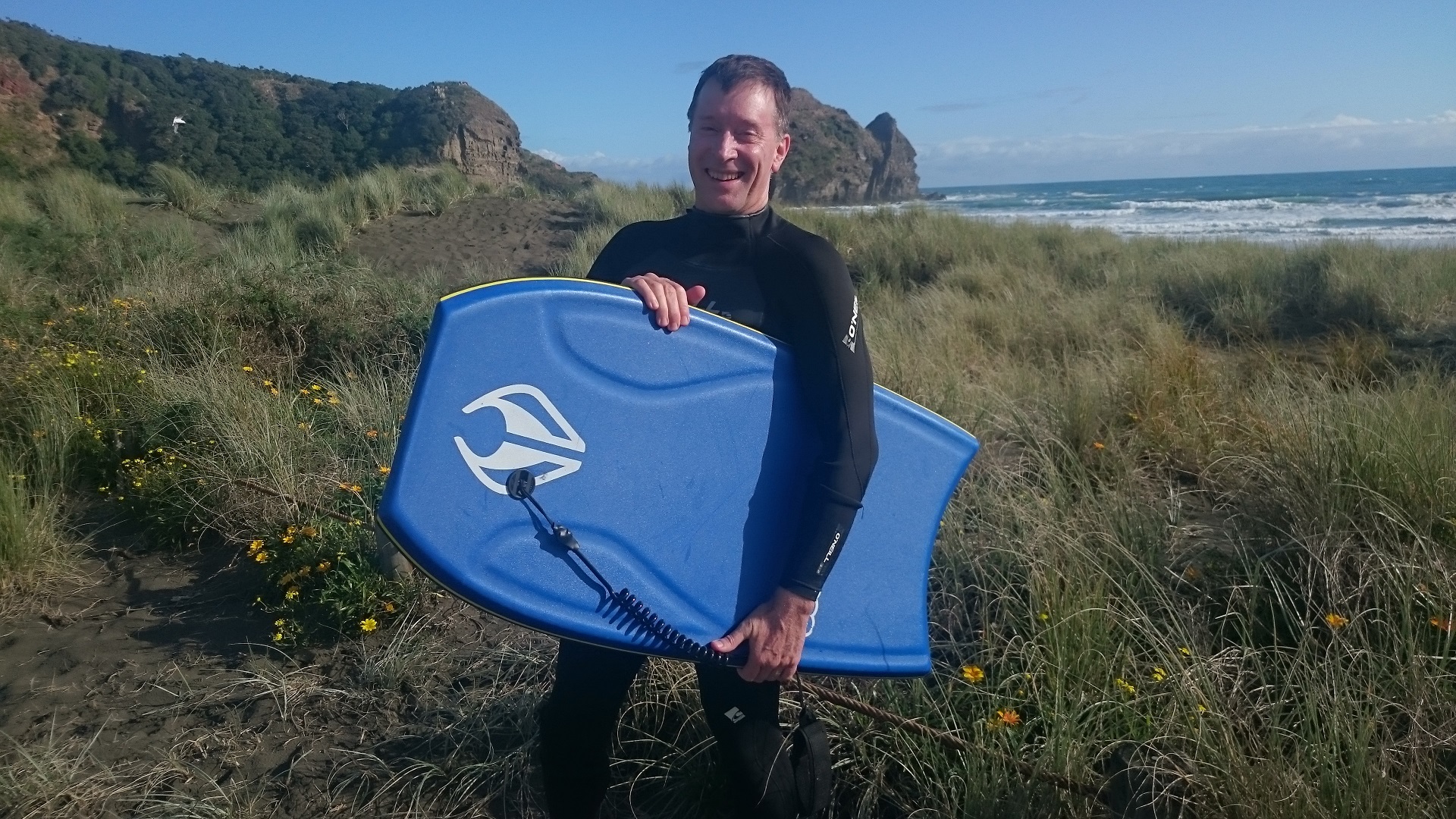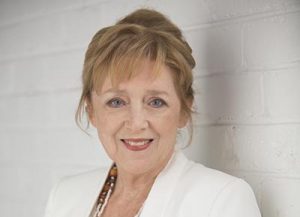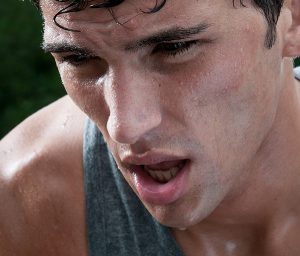
Asthma not a life sentence?
Glenn at Piha. “At 61 years of age I have more energy, am more active and enjoy physical activities like boarding without symptoms or need of an asthma puffer.”
Maybe you, like me, have the gene for asthma – and yes, I had daily asthma symptoms from the age of 2 to 42. But what if, like me, you could be free of asthma symptoms and the need for asthma drugs? At 61, I am now 18 years asthma free and drug free.
Some asthma statistics
The world Health Organisation (WHO) estimates some 235 million people currently suffer from asthma. According to the latest WHO estimates, released in December 2016, there were 383,000 deaths due to asthma in 2015.
According to Australia one in nine Australians have asthma, around 2.5 million. It’s more common in males aged 0–14, but among those aged 15 and over, asthma is more common in females. The rate of asthma among Indigenous Australians is almost twice as high as that of non-Indigenous Australians.
The latest New Zealand Health Survey reports 521,000 people take medication for asthma, one in nine adults and one in seven children.
Tuesday 1st May 2018 is World Asthma Day and I want to do more than just raise awareness about asthma. What if asthma doesn’t have to be for a lifetime?
Glenn’s story
Eighteen years ago, I almost died from asthma, not once but three times. I was forty-two and had suffered from asthma since the age of two. But as I got older it got worse and that summer of 2000 in London could easily have been my last.
The third asthma attack in a week came on suddenly as I was sitting in a London café. I was pumping my blue inhaler, but my lungs were getting tighter and I started to panic. I ran from the café jumped into a London cab and the driver bolted to the nearest hospital.
Staggering into the entrance of University College Hospital off Euston I was going blue and that got me instant service. White coated interns whisked me past the waiting hordes and the sign announcing a four-hour wait was clearly not for me. Within seconds I was being nebulised. Engulfed by clouds of vaporised salbutamol, little by little I started to feel the air making its way into my lungs and realised I was going to live. Within an hour I was breathing well enough to walk and having a fear of hospitals and putting on my best I’m well enough to go home face, persuaded the doctors to release me.
So, armed with pills and puffers I made my way back home. But despite the brave face, I felt backed into a corner. I was already on the maximum dose of inhaled steroid preventer and still needing 10-20 puffs of the blue inhaler every day. The nights were the worst and I would sleep with the blue inhaler on the pillow by my head.
Now I was back on the steroid tablets called Prednisone. The side effects from these and the inhaled steroid included oral thrush and frequent colds and bronchial infections that required me to be on regular courses of antibiotics. All drugs have side effects and I was by now permanently sick and tired.
Six months prior to this a friend had told me about a breathing method called Buteyko that was supposed to help asthmatics. I hadn’t paid much attention at the time but now I was prepared to try anything. That night I managed to track down a practitioner called Russell Stark. He was running a Buteyko course the next week in Newcastle and he said if I made my way up there he could help me.
Russell explained that the Buteyko breathing technique is a simple management strategy that controls asthma symptoms by helping to restore normal breathing. It is named after Professor Konstantin Buteyko who developed the programme in Russia more than fifty years ago.
I was sceptical about Russell’s claims but was prepared to try anything after my near-death experiences. So, I made my way up to Newcastle to start the course. I was amazed at the results. Within two days I was breathing freely and no longer puffing on my blue inhaler. Six weeks after completing the course, my GP said I could try reducing my preventer medication. Two weeks after that, I was able to stop all medication. I have been asthma-free and drug-free now for eighteen years.
That experience convinced me to give up a 20-year career as an exploration geologist. Within a year of my recovery I returned to the UK to train as a Buteyko practitioner to teach the breathing techniques that saved my life.
I returned to Auckland in 2001 and set up a clinic in Freemans Bay, Auckland. Since that time thousands of people have attended the clinic for help with asthma and other breathing disorders.
So how does the programme work?
Clients are taught breathing exercises and introduced to life style guidelines that permit them to perform all their daily activities without experiencing breathlessness or asthma symptoms. Improvements may be noticeable within the first 24 hours. Many clients are able to relieve their symptoms and are no longer needing their reliever medication within the first week. Additional benefits may include better sleep, greater energy, less respiratory infections and the ability to exercise without getting breathless or needing the blue puffer.
Buteyko Institute practitioners follow international best-practise guidelines for the use of medications: that asthmatics take their preventers as prescribed and relievers as required.
So, what’s the theory behind the Buteyko method?
The Asthma and Respiratory Foundation of New Zealand recognises that “over-breathing” is a key component of asthma attacks. That may seem contradictory to people who have spent their lives struggling for breath, but that gold-fish gulping for air is the result of an imbalance of oxygen and carbon dioxide which causes smooth muscle around the airways to constrict in people prone to asthma.
While most people have homeostatic systems which automatically rectify that imbalance, people with asthma can over-react in a similar way to the anaphylactic shock some people get from a bee sting. Buteyko teaches breathing habits which help regulate the blood-gas balance to prevent the onset of attacks.
Buteyko Institute practitioners explain the physiology and chemistry of gas exchange in workshops, so I won’t fill up column space here. What really matters is that breathing retraining is an effective way to prevent and control asthma.
There are now 12 published trials of the Buteyko Method for asthma. Typical of these is a six-month case-control study at Gisborne Hospital showed an 85 per cent reduction in inhaled relievers and a 50 per cent reduction in inhaled steroids. The control group showed a 37 per cent reduction in reliever medication and no change in their use of preventer medication after six months. The trial was published in the December 2003 edition of the New Zealand Medical Journal.
Gisborne Hospital’s Patrick McHugh said at the time that while it was a small study it showed that Buteyko could achieve significant reductions in the need for asthma medication.
Having found that the Buteyko method is safe and effective, McHugh said doctors need to reappraise what is best-practice for asthma. “For those for whom the Buteyko method works, it could offer them greater independence and a better quality of life”. “It gives people with asthma an evidence-based choice on how to manage their condition.”
Results like these have been replicated in all twelve published studies including a 2007 Calgary study and 2012 trial conducted in Egypt. Clinical trials
These results are no surprise to Buteyko Institute practitioners and our clients. We see results like this in every workshop.
The Buteyko Institute programme can be taught to children from three years, and adults of any age. The programme will work for you as it has for me, if you are prepared to put in the effort required.
So, if you don’t want to be just another asthma statistic contact a certified practitioner in your area and like me you can turn your life around. Click here to find a BIBH practitioner.
Glenn White BSc MSc
Glenn is a Buteyko Institute practitioner trainer and director of the Buteyko Breathing Clinic in Auckland, New Zealand
More about Glenn






